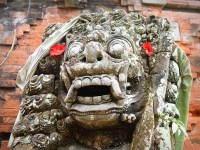
The small village of Batubulan is marked by stone figures of gods and demons on the side of the road. Known mostly for its stone carvings, Batubulan is a popular centre for cultural tourism and attracts travellers looking for a unique souvenir to take home with them. Visitors to the village can even enjoy visiting the workshops and watching the artists at work. Batubulan actually means 'moonstone' and stone carving has been the main industry of the village for a long time. Everybody seems to be an expert in the art and children learn how to coax statues out of rock at a young age. The village does also showcase other crafts, like woodwork and textiles, and is known for its antiques but the stone work dominates.The temples in the area reflect the traditional talent of the local inhabitants and some remarkable stone carvings are on display at temples such as Pura Puseh. Another of the village's specialities is the performance of the blessing dance of Barong, which is performed on a daily basis at five different locations or stages: the Puseh Temple, Tegal Tamu, Denjalan, Sahadewa and Sila Budaya. As the village has become such an artistic hub, other villages nearby have perfected their own crafts, and the whole region is slowly transforming in to a vast open-air market.
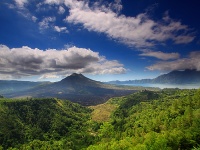
The still-active Gunung Batur volcano is known as Bali's second holiest mountain and symbolises the female element of the island. The male element is symbolized in Gunung Agung, a neighbouring smaller volcano. The walk up Mount Batur is not easy, but the views are spectacular and if you're lucky you might even spot a few monkeys along the way. Gunung Batur rises from a volcanic crater which also contains a lake and the view of this otherworldly landscape from the crater rim is spectacular. Look out for the remanants of black lava flows on the western side of the mountain from this vantage. There is also a great lookout point for those who'd rather hire a car and drive to the old crater rim overlooking Lake Batur.The sunrise walks are recommended, and remain the best way to avoid hiking during Bali's infamous year-round heat. Unfortunately, those visiting during the rainy season may be unlucky with the views as visibility is often poor. There is a guide hut situated at the bottom of the path and passing by usually attracts a mob of eager locals who insist on your taking one of them along for safety. If you want a guide, then this arrangement is convenient, however the hut can be avoided by taking alternative paths. It is safe to ascend on your own, but caution is always advised for less experienced hikers.
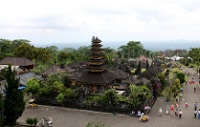
Locally known as the Mother Temple of Bali, Pura Besakih is located on the slopes of Mount Agung and is the biggest and holiest of all Balinese temples. Dating back to the 14th century, the three main temples are dedicated to Shiva, Brahma and Wisnu, and another 18 separate sanctuaries belonging to different regencies and caste groups surround these. The complex has been built over centuries and is very impressive.However, the magnificence of the experience can be somewhat blighted by the insistent local touts at the site. Apart from paying the official entrance fee, visitors are coerced into paying 'donations' to the temple and are forced into hiring tour guides. For this reason you may be advised to skip Pura Besakih in favour of some of the less famous and less crowded temples. Being aware of some of the common tourist scams, however, does makes the visit easier: it is possible to explore without a guide but you will be endlessly bothered, so it may be preferable to be with a local. If you do visit Pura Besakih, or any other temple for that matter, it is customary to wear a sarong out of respect for local traditions. Despite the hassle of dealing with touts, this is a beautiful and interesting attraction and many will find it rewarding regardless.
Address : Desa Besakih, Kec. Rendang, Karangasem, Besakih, Karangasem, Kabupaten Karangasem
Website : www.bali.com/temple_Karangasem_Pura-Besakih_83.html
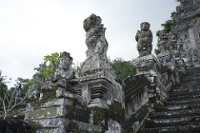
One of the most valued temples in Bali, Pura Kehen is a garden temple located in the town of Bangli in East Bali and can be traced back to the 11th century. Founded by Sri Brahma Kemuti Ketu, Pura Kehen is the second largest temple on Bali and the most sacred in the region. Many visitors are mesmerized by the temple's grandeur and the steep steps leading dramatically up to the gateway. Like the Mother Temple of Pura Besakih, Pura Kehen was built on the slope of a hill and has eight terraces. The temple complex is surrounded by palm tree plantations which adds to the visitor's impression of being a jungle explorer discovering something ancient and profound. The fire god, Brahmen, protects the temple and it is named for him - kehen means hearth or fireplace. The 38 steps lead to an ornately carved entrance and through this doorway there are three courtyards. There is a lot to see but be sure not to miss the remarkable stone lotus throne dedicated to Brahma, Shiva and Vishnu in the third, main courtyard.You will need to dress appropriately to visit the temple which means that your legs must be covered and you must have a temple-scarf (sarong) around your waist. You can rent sarongs at the temple.
Address : Desa Cempaga, Cempaga, Kec. Bangli, Kabupaten Bangli
Website : www.greenerbali.com/pura-kehen.html
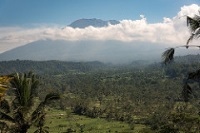
A typical Balinese village tucked away in a lush green valley, Sidemen is a popular excursion on Bali for tourists looking for peace and quiet. Terraced rice paddies lie under the shadow of a volcano, which offers good opportunities for hiking. Other active pursuits in the valley include cycling and whitewater rafting.The village of Sidemen is known for its skilful weavers, who make the intricate silver-and-gold songket fabric used in traditional weddings. The Pelangi Workshop allows visitors to watch the weaving process, and there are several shops in town to buy songket fabric along with other souvenirs.One of the most pleasant activities for those who want a relaxed break is strolling through the rice paddies and exploring the enchanting scenery of the valley. Most of the hotels have basic maps to give visitors and there are some beautiful little temples hidden in the countryside. Getting lost round here is a joy. There are some hotels and restaurants to cater to tourists but there are no real banking facilities and only limited internet access. Sidemen is a truly wonderful place to visit if you want to experience a quiet, traditional village, and it is worth spending at least one night to experience the surroundings. Many choose to spend more than that.
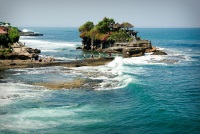
Meaning 'land in the middle of the sea', Tanah Lot is an exquisite sea temple built atop a rock formation off the island of Bali. A very popular tourist spot and a great location for photographs, Tanah Lot sits on a rocky island, in waters occupied by poisonous sea snakes which are believed to guard the temple from evil spirits and intruders. If you think its sounds like a fairytale you're not wrong; the place has a mystical quality. Despite the alleged presence of the snakes it is possible - and fun - to walk or wade to the temple cave at low tide. The temple was built by one of the last priests to arrive in Bali from Java in the 16th century and unfortunately the main temple can't be entered.Sunrise and sunset are the best times to visit, although sunset is the most popular time and the crowds can somewhat ruin the atmosphere. There are a number of vantage points from which you can get lovely views of the temple, so its best to find one of them and settle down to admire the views and take some photographs. The complex is very touristy and commercial, with lots of shops and stalls selling souvenirs, snacks and the like, but it is still a remarkable attraction to visit and the coastline is very beautiful in itself.
Address : Located at Beraban village, Kediri district, Tabanan Regency on the South Coast
Website : www.tanahlot.net/home/
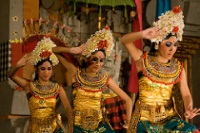
Set in the hills north of Denpasar, Ubud is the cultural centre of Bali. The major attractions of the town and its surrounding villages are the art museums and galleries, notably the Neka Museum, containing a huge collection of traditional and modern Balinese paintings. An enormous variety of Balinese art and crafts line the streets and crowd the marketplace of Ubud. Frequent performances of traditional dance and music, and restaurants offering some of the best food on the island, compel visitors to stay much longer than intended.In response to the demand from visitors all sorts of interesting attractions and activities have sprung up and you can now do things like attend silver smithing classes, learn yoga, or watch locals perform the Kekac Fire and Trance Dance. Ubud is also close to several sites of interest, including the 'Mother Temple' of Besakih, majestically situated high on the slopes of the Agung Volcano, and the popular Monkey Forest, where you can feed the many macaques in the temple complex. Hiking in the scenic Batur region with its volcano and lake are popular excursions. Many adventure trips can be organised from Ubud including canyoning, hiking, bird watching tours and the like.

Travel Guide powered by Word Travels, copyright © 2023 Globe Media Ltd. By its very nature information in this travel guide is subject to change at short notice and travellers are urged to verify information on which they're relying with the relevant authorities. Neither Globe Media Ltd nor Travel Vogue can accept any responsibility for any loss or inconvenience to any person as a result of information contained above.